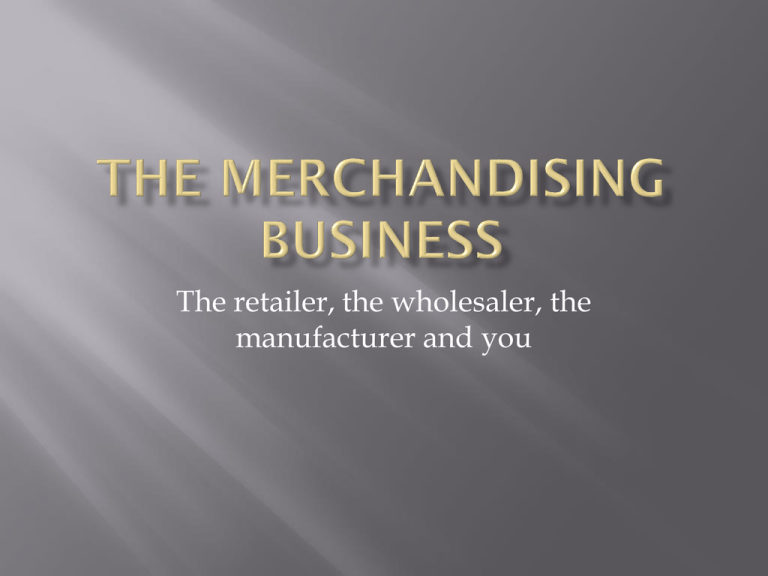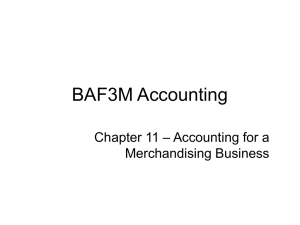The Merchandising Business
advertisement

The retailer, the wholesaler, the manufacturer and you A business that buys goods from a supplier and sells them back at a higher price Two types of merchandise business: A wholesaler is the business that buys goods from manufacturers and sells them to retailers A retailer is the business that buys goods from wholesalers and manufactures and sells it back to the public at a higher price Businesses that buy goods and sell them at a higher price are dealing with a merchandise business The number of merchandise on hand is known as merchandise inventory The merchandise inventory goes on the Balance Sheet The cost of goods sold goes on Income Statement Most commonly used The periodic inventory system is where the cost of goods sold is determined at the end of the fiscal period Businesses use this inventory system because, businesses do not have to keep-up-to-date on everything There is inventory at the beginning of the accounting period Merchandise is sold during accounting period Merchandise is replaced by purchased new stock from time to time The inventory at the end of the accounting period is almost the same as at the beginning The formula for calculating the cost of ending inventory is: Cost of beginning inventory + cost of merchandise purchased – cost of merchandise sold = cost of ending inventory The physical inventory is used to create financial statements It is a procedure where the unsold merchandise goods are accounted for An important current asset Needed to calculate the costs of goods sold figure on the income statement Will be used as the beginning inventory for the next accounting period Merchandise inventory is a current asset under accounts receivable because it will be normally sold and turned into cash within that fiscal period It is listed as its cost price and not its selling price (GAAP: The Cost Principle) The total cost of all the items sold is usually the biggest expense figure for a merchandising business The formula for finding the cost of goods sold is as follows: Cost of beginning inventory + cost of merchandise purchased - cost of ending inventory = cost of merchandise sold There are now six new headings on the income statement The inventory, the purchases, the cost of good available for sale (after adding both the purchases and the inventor) , the less inventory and the cost of goods sold After subtracting the cost of goods available for sale from the less inventory (the ending inventory) you will get your cost of goods sold which is subtracted from the sales and you will get your gross profit Most companies try to reach a specific target gross profit percentage (try to reach a percentage divided from sales) Physical inventory check is a time-consuming procedure Good for small businesses but not accurate and convenient for other larger businesses •Merchandise inventory of a business is kept in two accounts One is the merchandise inventory account, it shows inventory figure as of the beginning of the accounting period •At the fiscal year-end inventory is counted and valued at cost price at to arrive at merchandise inventory grand total •Merchandise inventory will now appear in the assets section of most of your trail balance. •Purchases is the other account where merchandise inventory of a business is kept •Purchases is a short version of “Purchases of Merchandise for Resale” •Found in the assets section of the ledger. Merchandise for Resale Purchased for Cash Dr Purchase $$$ Hst Recoverable $$$ Bank Cr $$$ If Merchandise for Resale purchased on Account Dr Cr Purchases $$$ Hst Recoverable $$$ A/P $$$ •Revenue account for a merchandising business is called “Sales” If Goods sold for Cash Dr Cr Bank $$$ Hst Payable Sales $$$ $$$ If Goods sold on Account Dr Accounts Receivable $$$ Hst Payable Sales •When Cr $$$ $$$ a business sells its goods, the inventory is reduced. No accounting entries are made to show this when the Periodic System is used. You must know how to put the merchandising inventory, purchase and freight-in. The 3 steps to enter the new accounts The beginning inventory is extended to the debit column of the income statement. • Ending inventory was entered in both the credit column of the income statement and in the debut column of the balance sheet • The amounts for the freight-in and purchases were transferred to the debit column of the income statement. • The beginning inventory, purchases and freight-in are represents cost and they are all shown as debits on the worksheet. The ending inventory is shown as a credit because it’s a deduction in the calculation, Ending inventory represents goods purchased but not sold. The higher the ending inventory the lower the cost of goods sold. Closing Entries The closing entry process now automatically updates the inventory account at the end of the fiscal period. Section 11.4 In the books of a seller, a sales invoice would be recorded as follows: DR CR Accounts Receivable $565 Sales $500 HST Payable $65 Sometimes the seller will issue the customer a Credit Invoice. Such as defective merchandise or goods that the customer keeps but is not happy with, and or to correct an invoice that is not correct. Example of an adjustment: The seller would then make the following adjustment DR CR Sales $150 HST Payable $19.50 Accounts Receivable $169.50 A/R Customer 565 169.50 HST Payable 19.50 65 Sales 150 500 Some businesses may want to know part of their sales is being returned. Businesses use a special account called Sales Returns and Allowances. Sales Returns and Allowance HST Payable Accounts Receivable DR $150 $ 19.50 CR $169.50 In the books of a purchaser, a purchase invoice: DR CR Purchases $500 HST Recoverable $65 Accounts Payable - Vendor $565 If the customers get a credit invoice because they found a flaw or that some of the merchandise they purchased was defective. The seller is going to reduce their payment by debiting accounts payable. Accounts Payable Purchases HST Recoverable A/P 169.50 565 DR $169.50 CR $150 $19.50 HST Recoverable 65 19.50 Purchases 500 150 Some businesses may want to know part of their sales is being returned. Businesses use a special account called Purchase Returns and Allowances. Accounts Payable Purchase Returns and Allowances HST Recoverable DR $169.50 CR $150 $19.50 Revenue – The business needs to subtract all of the credit that they gave to customers: Sales – Sales Returns and Allowances = Net Sales Cost of Goods Sold – The business needs to subtract all of the merchandise that they purchased but returned because it was not satisfactory to them: Purchases – Purchase Returns and Allowances = Net Purchases How to use sales discounts and put them in accounting entries The arrangements made with the customers (when the goods or services are paid for and a cash discount is offered) Standards Terms of Sale C.O.D- Cash on delivery. The goods or merchandise must be paid right when the delivery is made On Account or Charge. The full amount of the invoice is due at the time the invoice is received but is usually given a set of days to pay it off, such as 30 days 30 Days or Net 30. The full amount of the invoice is due 30 days after the date of the invoice 2/10, n/30. Two percent discount when paid in ten days or full amount due in 30 days In the Books of the Buyer When the invoice is received the purchases is debited, the HST recoverable is debited and the Accounts Payable is credited If the buyer pays the amount but is offered a cash discount then the accounts payable is debited, the discounts earned is credited and the bank is credited In the Books of the Seller It is switched with the buyer The accounts receivable is deducted, the sales is credited and the HST recoverable is credited because you made a sell When the buyer pays the amount with the discount offered then the Debit bank Debit discounts allowed Credit accounts receivable It’s easier, better and lazier In bigger companies they use perpetual inventory system as faster alternative compared to the Periodic Inventory System. Example 50 portable stereo units were sold by sound wave electronics, a wholesaler. The purchaser is Fidelity sound, a retailer. The units cost sound wave electronics $45 each, they were sold on account to Fidelity Sound for $90. Sales Invoice 50 portable stereos costing $45 each are sold to Fidelity Sound for $90; terms 2/10, net 30. Total $4,500.00 plus Hst. Dr Cr Accounts Receivable 5085 Cost of Goods Sold 2250 Merchandise Inventory 2250 Sales 4500 Hst Payable 585 Credit Invoice Fidelity Sounds finds 10 of the portable stereos to be defective and returns them to sound wave electronics. Sales Returns & Allow. Hst Payable Merchandise Inventory Cost of Goods Sold Accounts Receivable Dr 900 117 450 Cr 450 1017 Fidelity sound pays the amount owned ($5085 less the return of $1017 equals $4068). Also, prompt payment earned a 2% discount. DR CR Bank 3986.64 Sales Discount 81.36 A/R 4068 Purchase Invoice 50 stereos are bought from sound wave electronics for $90; terms 2/10, net 30, total $4500, plus Hst DR CR Merchandise Inventory 4500 Hst Recoverable 585 Accounts Payable 5085 Credit Invoice Fidelity sounds finds 10 of the portable stereos to be defective and returns them to sound wave electronics Dr Cr Accounts Payable 1017 Merchandise Inventory 900 Hst Recoverable 117 Cheque Copy Fidelity Sound pays the amount owned ($5085 less the return of $1117 equals $4068). Also, prompt payment earns a 2% discount. Dr Cr Accounts Payable 4068 Bank 986.64 Discounts Earned 81.36









